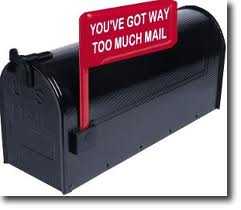Depending on which surveys you read, the average business person spends a minimum of 90 minutes a day reading email. In my experience, I think it's longer. And it's certainly become more pervasive now that smartphones, tablets, iPads and other mobile devices keep us attached to our email 24X7.
Whether it's a ding, a trill or a subtle vibration, you are never fully able to escape from the onslaught of communication.
Despite the fact that we've had email for a couple of decades now and many tools and methods have evolved to get it under control, most of us are still being controlled by our tools.
 There are some very basic methods you can use to get control of email and some tools - some embedded in your mail readers like Outlook and others that can be purchased like Mail Tags and Mail Act-On for the Mac - that can help automate your methods.Here are three tips:
There are some very basic methods you can use to get control of email and some tools - some embedded in your mail readers like Outlook and others that can be purchased like Mail Tags and Mail Act-On for the Mac - that can help automate your methods.Here are three tips:
Develop an email methodology. Email is a task generator - not a library. People send you email because they want you to READ, SCHEDULE, MEET, REVIEW, CONSIDER, VOTE, ATTEND, COMPLETE .. something. So set up a folder system based on actions. For example:
- Read Later (email that's interesting and requires no action from you)
- Waiting (email that will require an action once something else has been completed or email where you have assigned tasks and need to make sure they are completed by someone).
- Action (things I have to do/respond to today)
- Follow up (emails I need to follow up on in the next day or two)
Discipline yourself. Schedule specific times each day when you are going to read and act on email. Don't open your email every time a new message comes in.
Automate standard tasks. Every time you click on "Yes, I'd like to receive more information", that's another email that's coming into your mailbox on a regular basis. All of us get ads, newsletters, curated listings of topics you may find of interest, daily digests from FaceBook, LinkedIN, newspapers and magazines. Even if it's material you want, it is not demanding immediate action. Learn to set up rules that will automatically move these messages to your "Read Later" folder. Or, if it's something you no longer want, directly to your trash.
Rules in Outlook and Apple Mail can automatically categorize mail so it can be easily pulled up when you need it. In Outlook, an even more powerful feature is the ability to turn messages into tasks or appointments right through the inbox.
These steps can help you "triage" your mail based on what you need to "DO." Or often who needs to do it (think of all the emails you get copied on that really don't involve you).
The important thing is at the end of each day there should be something less than 15-20 emails in your inbox.
Remember: email is a tool to help you do your job, it is not your job. A construction worker isn't "hammering", he's building a house.
